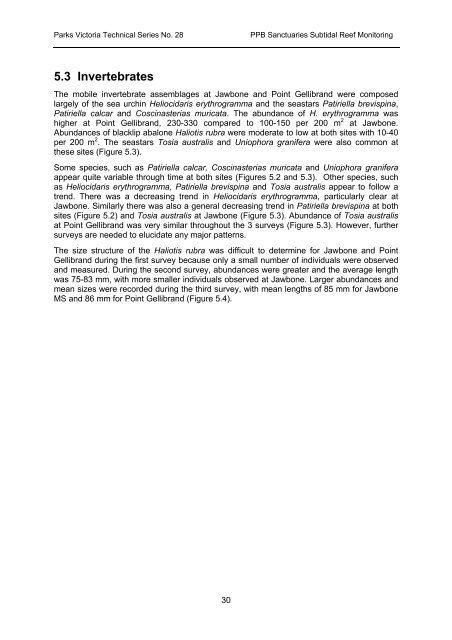Victorian Subtidal Reef Monitoring Program - Parks Victoria
Victorian Subtidal Reef Monitoring Program - Parks Victoria
Victorian Subtidal Reef Monitoring Program - Parks Victoria
You also want an ePaper? Increase the reach of your titles
YUMPU automatically turns print PDFs into web optimized ePapers that Google loves.
<strong>Parks</strong> <strong>Victoria</strong> Technical Series No. 28PPB Sanctuaries <strong>Subtidal</strong> <strong>Reef</strong> <strong>Monitoring</strong>5.3 InvertebratesThe mobile invertebrate assemblages at Jawbone and Point Gellibrand were composedlargely of the sea urchin Heliocidaris erythrogramma and the seastars Patiriella brevispina,Patiriella calcar and Coscinasterias muricata. The abundance of H. erythrogramma washigher at Point Gellibrand, 230-330 compared to 100-150 per 200 m 2 at Jawbone.Abundances of blacklip abalone Haliotis rubra were moderate to low at both sites with 10-40per 200 m 2 . The seastars Tosia australis and Uniophora granifera were also common atthese sites (Figure 5.3).Some species, such as Patiriella calcar, Coscinasterias muricata and Uniophora graniferaappear quite variable through time at both sites (Figures 5.2 and 5.3). Other species, suchas Heliocidaris erythrogramma, Patiriella brevispina and Tosia australis appear to follow atrend. There was a decreasing trend in Heliocidaris erythrogramma, particularly clear atJawbone. Similarly there was also a general decreasing trend in Patiriella brevispina at bothsites (Figure 5.2) and Tosia australis at Jawbone (Figure 5.3). Abundance of Tosia australisat Point Gellibrand was very similar throughout the 3 surveys (Figure 5.3). However, furthersurveys are needed to elucidate any major patterns.The size structure of the Haliotis rubra was difficult to determine for Jawbone and PointGellibrand during the first survey because only a small number of individuals were observedand measured. During the second survey, abundances were greater and the average lengthwas 75-83 mm, with more smaller individuals observed at Jawbone. Larger abundances andmean sizes were recorded during the third survey, with mean lengths of 85 mm for JawboneMS and 86 mm for Point Gellibrand (Figure 5.4).30
















